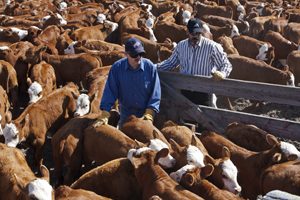Developing Faster, Less Expensive Diagnostic Tests
This article written by Dr. Reynold Bergen, BCRC Science Director, originally appeared in the October 1, 2018 issue of Canadian Cattlemen magazine and is reprinted on the BCRC Blog with permission of the publisher.

Last month’s column discussed how antibiotics are used in Western Canadian cow-calf operations. Respiratory diseases are a common reason for antibiotic treatment in cows, bulls, and calves and diarrhea is a common reason for antibiotic treatment in young calves. Because both respiratory and intestinal infections can involve many different microbes, having a better understanding of what microbes may be causing a particular animal to be sick could allow more appropriate treatment decisions. For example, antibiotics don’t kill viruses, so using antibiotics won’t help an outbreak of scours that is primarily viral in nature. Similarly, some antibiotics are more effective against some bacteria than others, so being able to select the antibiotic that is most appropriate for the bacteria that are involved would be helpful.
But it’s not that simple. These infections often involve multiple microbes at the same time. Some bacteria are normally found in the intestine or respiratory tract. These are called “commensals”, meaning that they’re supposed to be there, they’re typically harmless, and they may even be beneficial to the animal. Also, culture-based laboratory diagnostic tests have traditionally relied on individual culture tests for each microbe. These are slow, costly, labor-intensive, and can have trouble distinguishing pathogenic from commensal bacteria, or identifying the virus(es) involved. A 2013-18 Beef Science Cluster study led by the CFIA’s Aruna Ambagala and co-workers developed a prototype diagnostic system to overcome these challenges (A novel multiplex PCR-electronic microarray assay for rapid and simultaneous detection of bovine respiratory and enteric pathogens; Journal of Virological Methods 261:51-62).
What they did:
These researchers used genetic (DNA or RNA-based) techniques to identify microbes instead of the traditional approach of trying to grow microbes in the lab. The first technique (called polymerase chain reaction, PCR) involves finding one or more genetic sequences that correspond to a particular microbe and selectively duplicating or amplifying them many times so that they can be detected. Many unrelated microbes share similar genetic sequences, so the researchers were careful to design tests that were specific to genetic sequences only found in the targeted microbes. This ensured that the PCR would only amplify genetic sequences from the specific microbe they were looking for (if they were there) but not microbes that are closely related but harmless. It also allowed them to distinguish between commensal and pathogenic strains of the same microbes. The second step was to develop a system to confirm and further characterize the amplified genetic sequences from the PCR step.
Separate PCR amplification and detection tools were developed and tested for each microbe known to be involved in respiratory disease or diarrhea. Next, the tools were combined into four separate tests to amplify and detect genetic sequences from respiratory disease bacteria (Mannheimia, Histophilus, Pasteurella and Mycoplasma), respiratory viruses (PI-3, BRSV, IBR, coronavirus, BVD types 1, 2 and 3), diarrhea bacteria and protozoa (Clostridium, Salmonella, E. coli, and coccidiosis organisms), and diarrhea viruses (rotavirus, torovirus, coronavirus, BVD types 1, 2 and 3). Finally, the respiratory bacteria and virus assays were combined into one fully automated test, the diarrheal bacteria, protozoa and virus assays were combined into a second test, and both tests were evaluated using archived lab samples.
What they learned:
The new tests were highly specific, meaning that they only detected the specific microbes they were designed to detect, so false positives were rare. For instance, the test could distinguish between commensal Mannheimia and pathogenic Mannheimia, between harmless E. coli and enterotoxigenic or enterohemorrhagic E. coli, and between different types of BVD viruses. The new tests were also highly sensitive. This means that if the microbe the test was designed to find was in the sample even in low-numbers, the test found it, so false negatives were also rare. In fact, the new tests found some microbes that the original culture-based lab tests hadn’t detected. That can happen when microbe numbers are very low, or when they are very difficult to culture.
What it means:
Pending further validation and commercialization, the new tests are expected to cost considerably less than other currently available genetic-based diagnostic tests. They can generate results in six to eight hours, compared to one to two weeks for traditional culture approaches. This isn’t fast enough for real-time chute-side treatment decisions but may help veterinarians respond more quickly to herd health outbreaks in the future, and to further refine responsible antibiotic treatment decisions in cattle herds
The Canadian Beef Cattle Check-Off has increased from $1 to $2.50 per head in most provinces, with approximately 75 cents allocated to the Beef Cattle Research Council. Canada’s National Beef Strategy outlined why the Check-Off increase was needed, and how it would be invested. One goal laid out in the strategy was a 15% increase in production efficiencies, partly through research and development to improve diagnostic tests for animal health and welfare issues. This will provide the resources to further develop and refine diagnostic tests as technological advances allow further improvements in speed and automation at lower costs.
Click here to subscribe to the BCRC Blog and receive email notifications when new content is posted.
The sharing or reprinting of BCRC Blog articles is typically welcome and encouraged, however this article requires permission of the original publisher.
We welcome your questions, comments and suggestions. Contact us directly or generate public discussion by posting your thoughts below.